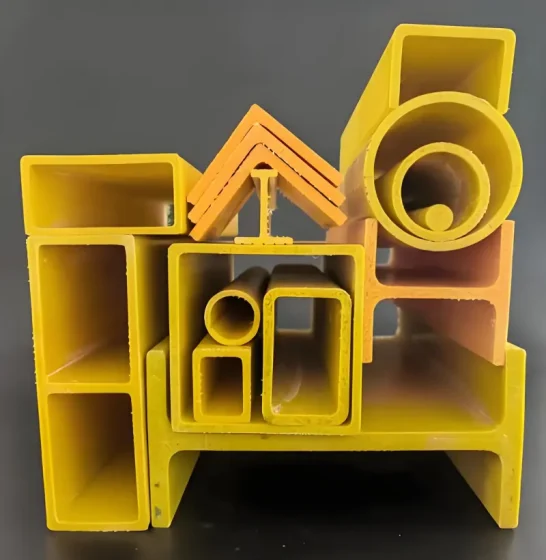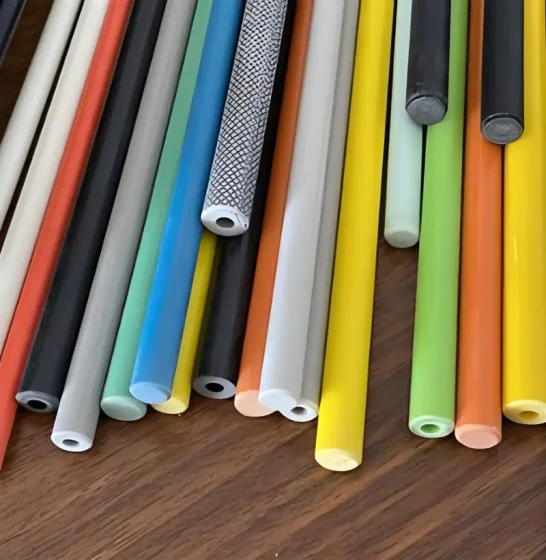FRP Pultruded Profiles Calculation Formulas— making “light, strong, non-conductive” a structural primary material
(also known as FRP pultruded rectangular profiles, pultruded fiberglass rectangular tubes, pultruded FRP rectangular sections)
 Lead:
Lead:
Lightweight FRP Pultruded Rectangular Tubes replace steel frames and platforms where conductivity and weight are critical problems. Steel meets strength but brings two hard drawbacks: it conducts—so a busbar breakdown makes the whole frame a fault path—and it’s dense (7.85 g/cm³), which means heavy, hard-to-handle members in confined or high-elevation installations. Replacing the section with pultruded glass-fiber reinforced polymer (FRP) rectangular tubing reduces weight by ~75% while delivering dielectric strength >30 kV. One profile can combine load-bearing, insulation and weight savings. Below are field-tested metrics and hard spec items from 220 kV substation platforms, offshore wind-turbine interiors and metro third-rail projects, organized as Design → Manufacture → Installation specs you can drop into technical specifications.
1. Why this matters (problem statement)
Traditional steel fences and work platforms:
Conductive: a busbar flashover converts the structure into a fault loop.
Heavy: high density makes single-worker handling impossible in cramped or high spaces; cranes may not have access.
Pultruded FRP rectangular tubes give ~75% mass reduction plus bulk insulation and high breakdown voltage — enabling “structure = insulation + support + lightness.”
2. Materials & process requirements
2.1 Fiber system — electrical grade ECR glass
Use ECR glass (chloride- and fluorine-free) for electrical applications: bulk resistivity ≈ 10¹⁴ Ω·cm (≈100× ordinary E-glass), tensile strength ~2,400 MPa, modulus ~80 GPa.
Recommended layup proportions: 0° plies ≥ 60% (primary load), ±45° ≈ 20% (shear), remainder 90° ≈ 20% to control transverse shrinkage.
2.2 Resin system — insulating epoxy-vinyl ester
Specify an electrical-grade epoxy-vinyl ester (epoxy equivalent ~180; styrene ~35%). Post-cure dielectric strength ≥ 25 kV/mm and arc-resistance ≥180 s.
Pultrusion parameters: speed 0.4 m/min, die temperature 140 ±5 °C. Degree of cure ≥95% (DSC residual ΔHc < 5 J/g).
2.3 Surface veil / finish
Add a 20 g/m² polyester surface veil and a resin-rich surface layer (~0.1 mm) to cover exposed fiber “bristles” that act as micro-electrodes; this raises inception voltage for partial discharge by ~15%.
3. Section & mechanical performance (example section)
Section: 50 × 30 × 3.5 mm pultruded rectangular tube — measured properties:
Mass: 0.72 kg/m (same size: aluminum box 1.35 kg/m; Q235 steel box 3.94 kg/m)
Flexural strength (ASTM D7264): ~580 MPa
Flexural modulus: ~28 GPa
Interlaminar shear (short-beam): ~45 MPa
Poisson’s ratio: 0.28 — stable transverse response suitable for bolted cluster connections
4. Electrical properties
4.1 Dry dielectric withstand
30 kV / 1 min no flashover on 3.5 mm wall (field ≈ 8.6 kV/mm; safety factor ≈ 2.9).
4.2 Wet dielectric withstand
After 24 h water immersion: 25 kV / 1 min pass — meets GB/T 1303.2-2009 wet-condition insulation requirement (≥20 kV).
4.3 Leakage current
At 11 kV system voltage and RH 93%, leakage current measured ~12 µA, about 1/5 of comparable porcelain insulators under the same conditions.
4.4 Flame & smoke performance
With 3% Sb₂O₃ + 5% ATH additive: LOI ~32%, UL94 V-0. Smoke production ~25 DM·min⁻¹, meeting low-smoke requirements for rolling-stock/tunnel applications.
(Mid-article keyword placement: note how Lightweight FRP Pultruded Rectangular Tubes provide both structural capacity and bulk insulation in these electrical tests.)
5. Connections & equipotential bonding
5.1 Adhesive + fastener hybrid (recommended)
Through-holes in laminate are prone to splitting. Use 6061-T6 aluminum sleeve inserts with OD 6 mm larger than drilled hole; bond insert with epoxy adhesive (e.g., DP460). Post-cure pull-out ≥8 kN (≈3× bare hole).
5.2 Induced/eddy current mitigation & equipotentiality
FRP is non-magnetic and insulating; metallic inserts are conductive. Add 2 mm copper braided jumpers at joints and segment breaks to ensure equipotential continuity. Short-circuit test 50 kA / 0.3 s showed no insert burn-through.
5.3 Thermal expansion compensation
Axial CTE ≈ 6×10⁻⁶ /°C (about half of steel’s 12×10⁻⁶ /°C). For a 3 m member with ΔT 60 °C, axial movement ≈ 1.1 mm. Use oblong (waist-shaped) bolt slots + stainless steel sliding shoes to prevent thermal stresses from concentrating into the adhesive layer around inserts.
6. Typical applications & field data
6.1 220 kV GIS maintenance platform
Platform: 6 m × 1 m; live load 2 kN/m².
Main beams: 50×30×3.5 mm pultruded tubes at 600 mm centers.
Measured deflection: L/350, meeting GB 50017 for access platforms.
System weight: ~38 kg — two workers can carry inside without crane.
Ground capacitance: ~28 pF vs steel platform ~320 pF — partial discharge test background noise reduced ~6 dB.
6.2 Offshore wind turbine internal ladder
Design concentrated load: 1 kN at rung. Use 40×40×4 mm pultruded square tube, factory-applied 0.2 mm UV polyurethane topcoat.
Salt spray: 720 h – no fiber exposure.
Ladder weight: ~22 kg (≈18 kg lighter than aluminum ladder) — single-person hand-carry inside 25 m tower, reduces vessel hoisting by ~0.5 day.
6.3 Metro third-rail maintenance walkway
Walkway width 0.6 m, live conductor clearance 220 mm, DC 825 V.
Composite: pultruded tubes + molded grating treads — system dielectric withstand 4 kV / 1 min, meeting EN 50153 for contact-possible components (3.5 kV).
Fire performance: UL94 V-0; retains ~70% strength after 300 °C × 15 min, providing evacuation time window.
7. Inspection & acceptance checklist (factory/site sampling)
Visual: no exposed fibers; bubbles ≤ 1 mm
Dimensions: width ±0.3 mm; thickness ±0.2 mm; straightness ≤1 mm/m
Mechanical sampling: 2% three-point bending test, strength ≥ 550 MPa
Electrical sampling: 3.5 mm wall sample: 30 kV /1 min zero breakdown
Flame & smoke: LOI ≥30%; UL94 V-0
Inserts: pull-out ≥ 8 kN; adhesive layer no cracks
8. Conclusion — why specify pultruded FRP rectangular tubing as a primary material
FRP pultruded rectangular tubes embed insulation into the structural member, not as an add-on. If you design up front for fiber orientation, insert potential equalization and thermal movement, a single pultruded tube can replace the “steel frame + insulator” two-stage solution — halving weight, shortening schedule and cutting maintenance. Remember: electrical safety derives from non-conductive bulk properties, not from wrapped insulation alone — precisely why Lightweight FRP Pultruded Rectangular Tubes belong on the bill-of-materials as structural primary profiles.
 FRP/GRP Grating & Profiles Manufacturer – Custom Pultruded Solutions
FRP/GRP Grating & Profiles Manufacturer – Custom Pultruded Solutions




Scan the QR Code with WeChat